Managerial Accounting Assignment Solution - University Name
VerifiedAdded on 2022/09/18
|9
|990
|22
Homework Assignment
AI Summary
This managerial accounting assignment solution addresses various key concepts within the field. It begins with cost accounting, calculating overhead allocation using both traditional and activity-based costing methods. The solution proceeds to incremental analysis, assessing the profitability of different purchasing and manufacturing options. It then delves into cost-volume-profit (CVP) analysis, comparing the current and automated approaches, including breakeven points, margin of safety, and operating leverage. Standard costs are explored, focusing on determining labor hour standards and material costs. Finally, the assignment includes ratio analysis, matching companies with their respective industries based on financial characteristics. The assignment also provides answers to multiple-choice questions related to cost accounting and equivalent units of production.
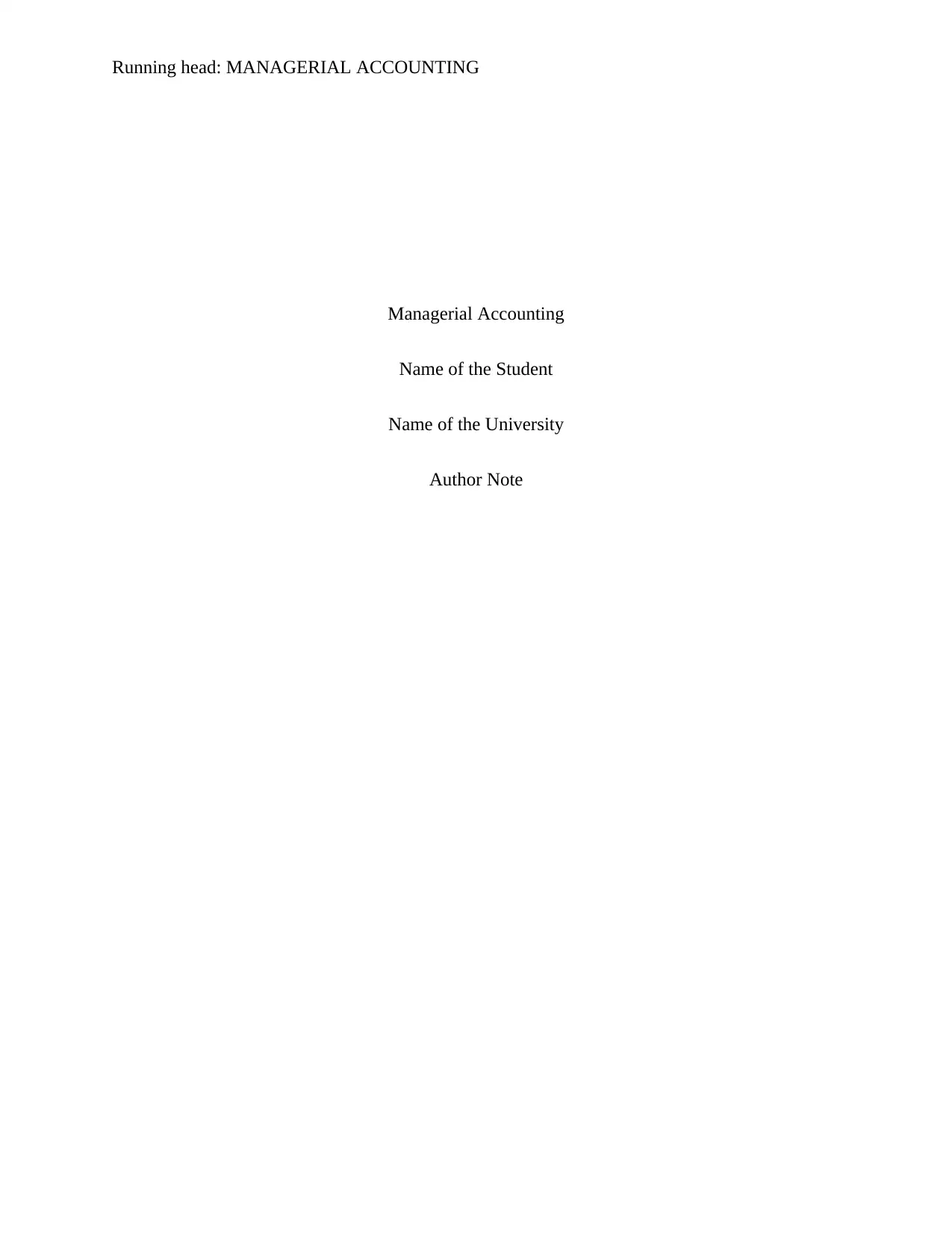
Running head: MANAGERIAL ACCOUNTING
Managerial Accounting
Name of the Student
Name of the University
Author Note
Managerial Accounting
Name of the Student
Name of the University
Author Note
Paraphrase This Document
Need a fresh take? Get an instant paraphrase of this document with our AI Paraphraser
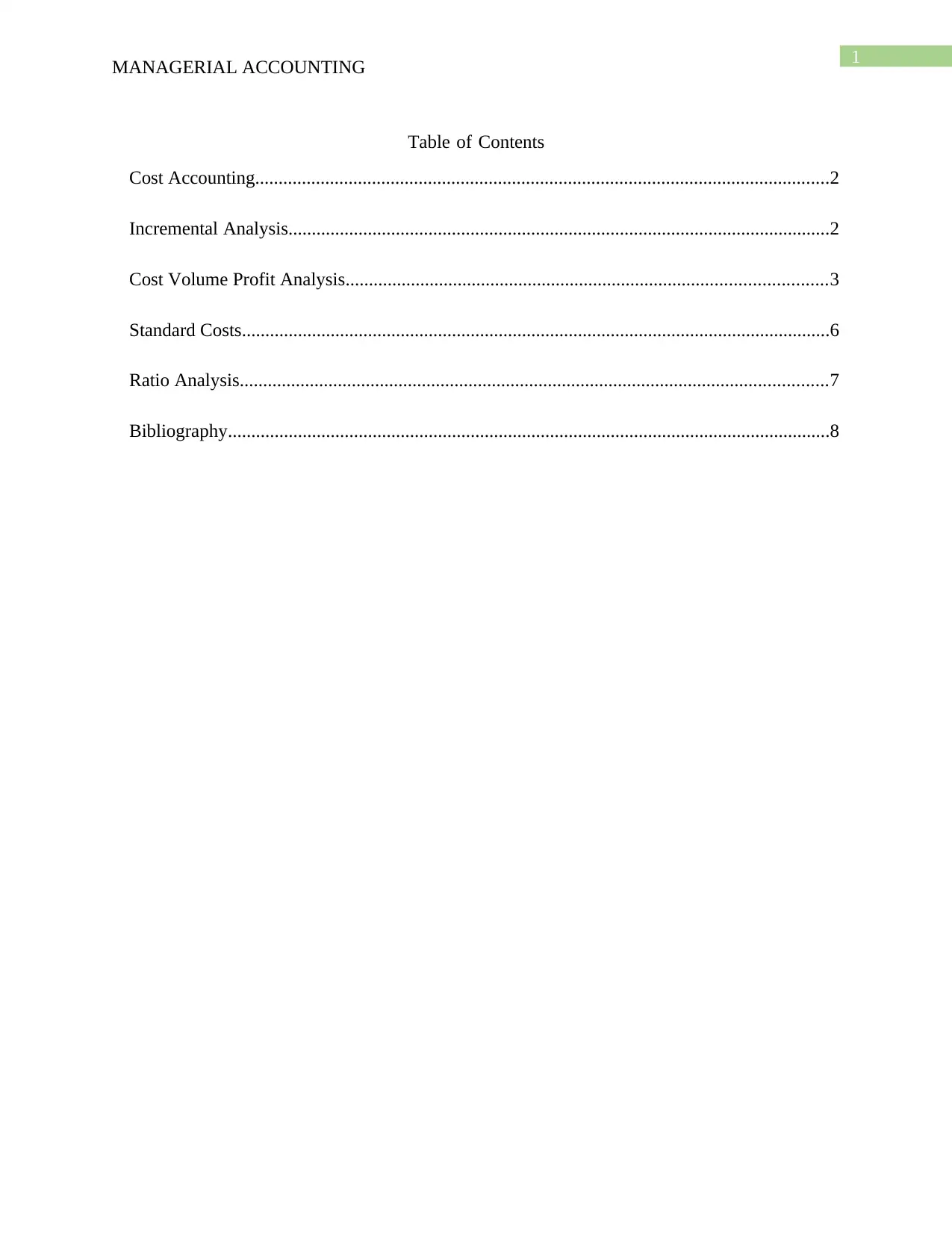
1
MANAGERIAL ACCOUNTING
Table of Contents
Cost Accounting...........................................................................................................................2
Incremental Analysis....................................................................................................................2
Cost Volume Profit Analysis.......................................................................................................3
Standard Costs..............................................................................................................................6
Ratio Analysis..............................................................................................................................7
Bibliography.................................................................................................................................8
MANAGERIAL ACCOUNTING
Table of Contents
Cost Accounting...........................................................................................................................2
Incremental Analysis....................................................................................................................2
Cost Volume Profit Analysis.......................................................................................................3
Standard Costs..............................................................................................................................6
Ratio Analysis..............................................................................................................................7
Bibliography.................................................................................................................................8
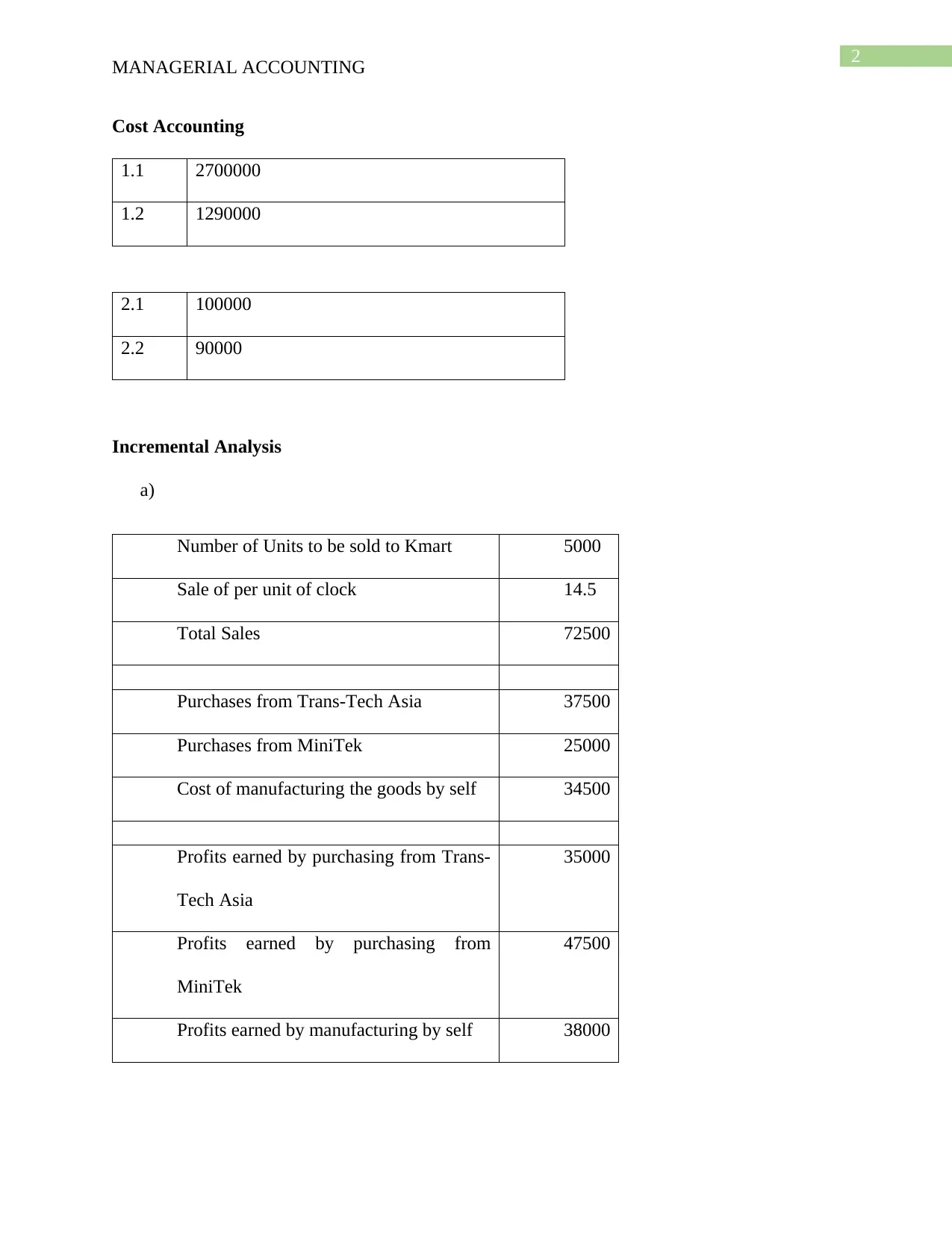
2
MANAGERIAL ACCOUNTING
Cost Accounting
1.1 2700000
1.2 1290000
2.1 100000
2.2 90000
Incremental Analysis
a)
Number of Units to be sold to Kmart 5000
Sale of per unit of clock 14.5
Total Sales 72500
Purchases from Trans-Tech Asia 37500
Purchases from MiniTek 25000
Cost of manufacturing the goods by self 34500
Profits earned by purchasing from Trans-
Tech Asia
35000
Profits earned by purchasing from
MiniTek
47500
Profits earned by manufacturing by self 38000
MANAGERIAL ACCOUNTING
Cost Accounting
1.1 2700000
1.2 1290000
2.1 100000
2.2 90000
Incremental Analysis
a)
Number of Units to be sold to Kmart 5000
Sale of per unit of clock 14.5
Total Sales 72500
Purchases from Trans-Tech Asia 37500
Purchases from MiniTek 25000
Cost of manufacturing the goods by self 34500
Profits earned by purchasing from Trans-
Tech Asia
35000
Profits earned by purchasing from
MiniTek
47500
Profits earned by manufacturing by self 38000
⊘ This is a preview!⊘
Do you want full access?
Subscribe today to unlock all pages.

Trusted by 1+ million students worldwide
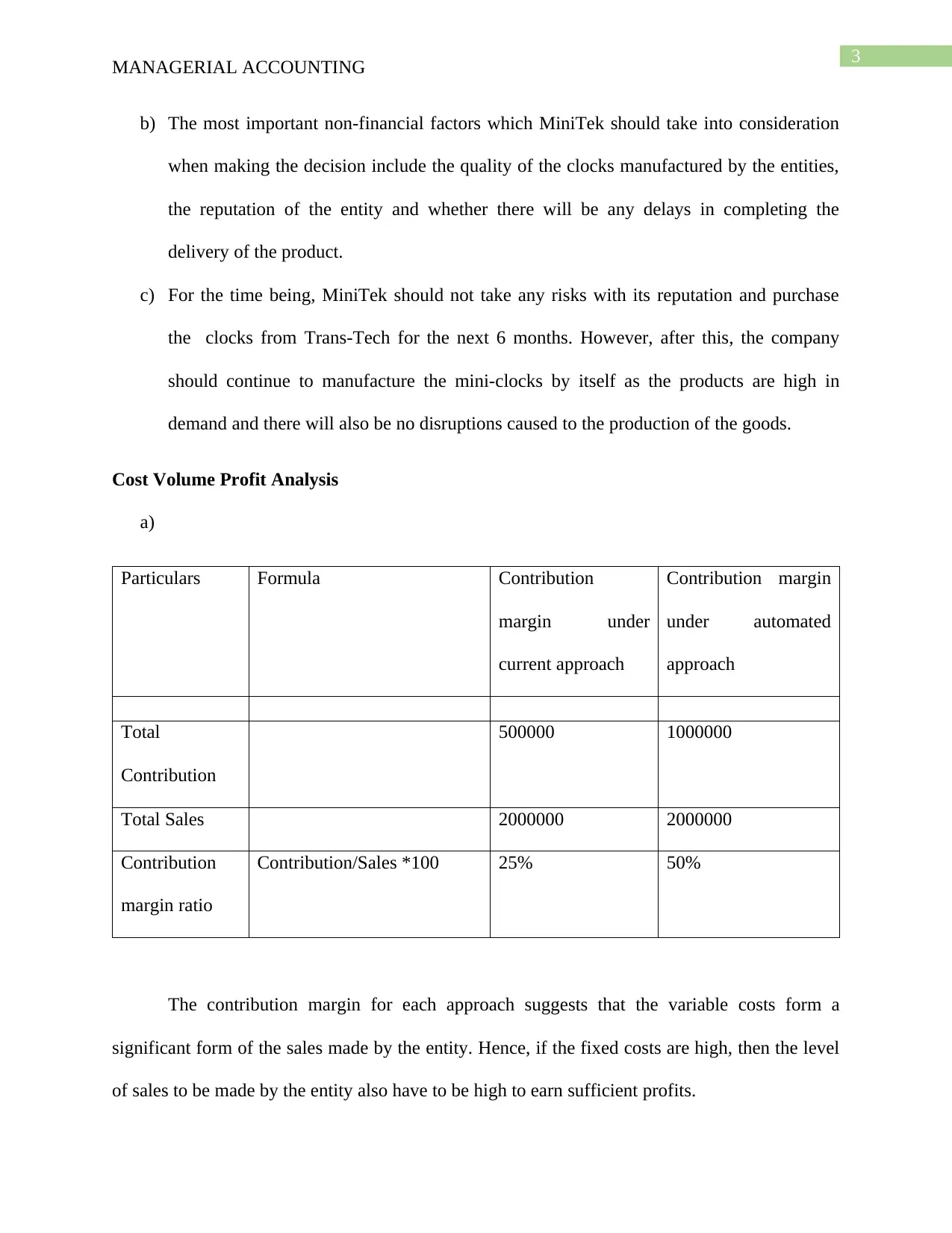
3
MANAGERIAL ACCOUNTING
b) The most important non-financial factors which MiniTek should take into consideration
when making the decision include the quality of the clocks manufactured by the entities,
the reputation of the entity and whether there will be any delays in completing the
delivery of the product.
c) For the time being, MiniTek should not take any risks with its reputation and purchase
the clocks from Trans-Tech for the next 6 months. However, after this, the company
should continue to manufacture the mini-clocks by itself as the products are high in
demand and there will also be no disruptions caused to the production of the goods.
Cost Volume Profit Analysis
a)
Particulars Formula Contribution
margin under
current approach
Contribution margin
under automated
approach
Total
Contribution
500000 1000000
Total Sales 2000000 2000000
Contribution
margin ratio
Contribution/Sales *100 25% 50%
The contribution margin for each approach suggests that the variable costs form a
significant form of the sales made by the entity. Hence, if the fixed costs are high, then the level
of sales to be made by the entity also have to be high to earn sufficient profits.
MANAGERIAL ACCOUNTING
b) The most important non-financial factors which MiniTek should take into consideration
when making the decision include the quality of the clocks manufactured by the entities,
the reputation of the entity and whether there will be any delays in completing the
delivery of the product.
c) For the time being, MiniTek should not take any risks with its reputation and purchase
the clocks from Trans-Tech for the next 6 months. However, after this, the company
should continue to manufacture the mini-clocks by itself as the products are high in
demand and there will also be no disruptions caused to the production of the goods.
Cost Volume Profit Analysis
a)
Particulars Formula Contribution
margin under
current approach
Contribution margin
under automated
approach
Total
Contribution
500000 1000000
Total Sales 2000000 2000000
Contribution
margin ratio
Contribution/Sales *100 25% 50%
The contribution margin for each approach suggests that the variable costs form a
significant form of the sales made by the entity. Hence, if the fixed costs are high, then the level
of sales to be made by the entity also have to be high to earn sufficient profits.
Paraphrase This Document
Need a fresh take? Get an instant paraphrase of this document with our AI Paraphraser
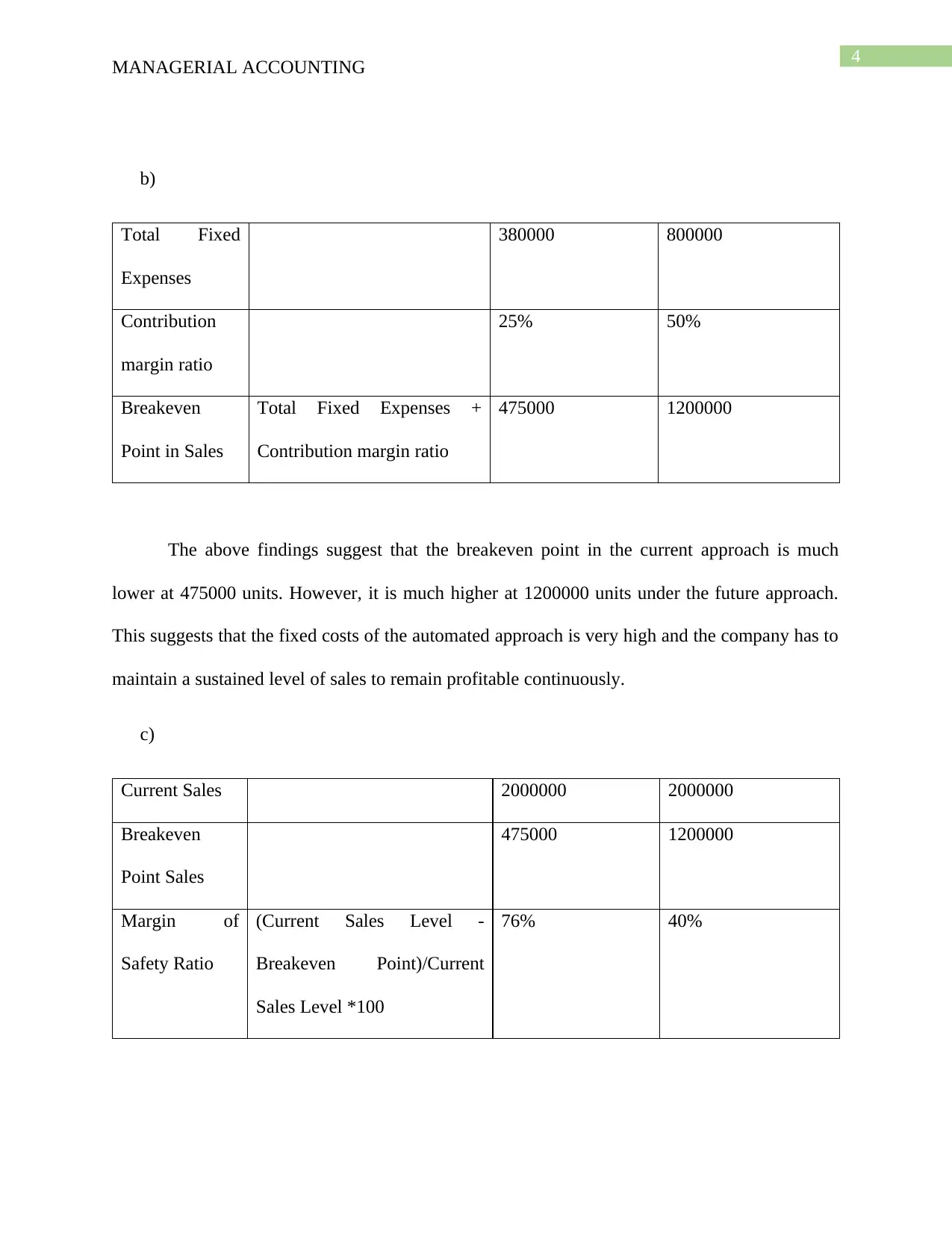
4
MANAGERIAL ACCOUNTING
b)
Total Fixed
Expenses
380000 800000
Contribution
margin ratio
25% 50%
Breakeven
Point in Sales
Total Fixed Expenses +
Contribution margin ratio
475000 1200000
The above findings suggest that the breakeven point in the current approach is much
lower at 475000 units. However, it is much higher at 1200000 units under the future approach.
This suggests that the fixed costs of the automated approach is very high and the company has to
maintain a sustained level of sales to remain profitable continuously.
c)
Current Sales 2000000 2000000
Breakeven
Point Sales
475000 1200000
Margin of
Safety Ratio
(Current Sales Level -
Breakeven Point)/Current
Sales Level *100
76% 40%
MANAGERIAL ACCOUNTING
b)
Total Fixed
Expenses
380000 800000
Contribution
margin ratio
25% 50%
Breakeven
Point in Sales
Total Fixed Expenses +
Contribution margin ratio
475000 1200000
The above findings suggest that the breakeven point in the current approach is much
lower at 475000 units. However, it is much higher at 1200000 units under the future approach.
This suggests that the fixed costs of the automated approach is very high and the company has to
maintain a sustained level of sales to remain profitable continuously.
c)
Current Sales 2000000 2000000
Breakeven
Point Sales
475000 1200000
Margin of
Safety Ratio
(Current Sales Level -
Breakeven Point)/Current
Sales Level *100
76% 40%
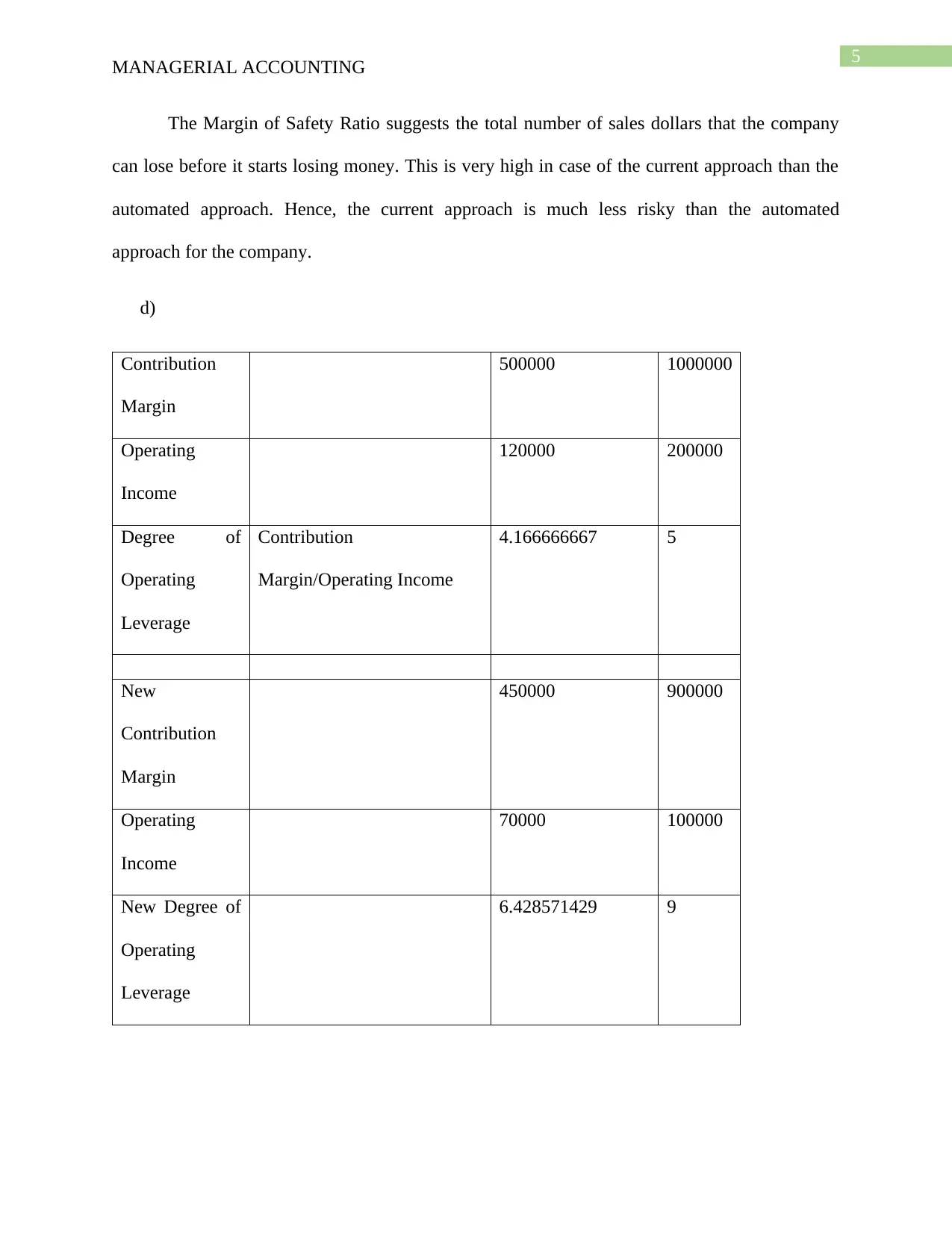
5
MANAGERIAL ACCOUNTING
The Margin of Safety Ratio suggests the total number of sales dollars that the company
can lose before it starts losing money. This is very high in case of the current approach than the
automated approach. Hence, the current approach is much less risky than the automated
approach for the company.
d)
Contribution
Margin
500000 1000000
Operating
Income
120000 200000
Degree of
Operating
Leverage
Contribution
Margin/Operating Income
4.166666667 5
New
Contribution
Margin
450000 900000
Operating
Income
70000 100000
New Degree of
Operating
Leverage
6.428571429 9
MANAGERIAL ACCOUNTING
The Margin of Safety Ratio suggests the total number of sales dollars that the company
can lose before it starts losing money. This is very high in case of the current approach than the
automated approach. Hence, the current approach is much less risky than the automated
approach for the company.
d)
Contribution
Margin
500000 1000000
Operating
Income
120000 200000
Degree of
Operating
Leverage
Contribution
Margin/Operating Income
4.166666667 5
New
Contribution
Margin
450000 900000
Operating
Income
70000 100000
New Degree of
Operating
Leverage
6.428571429 9
⊘ This is a preview!⊘
Do you want full access?
Subscribe today to unlock all pages.

Trusted by 1+ million students worldwide
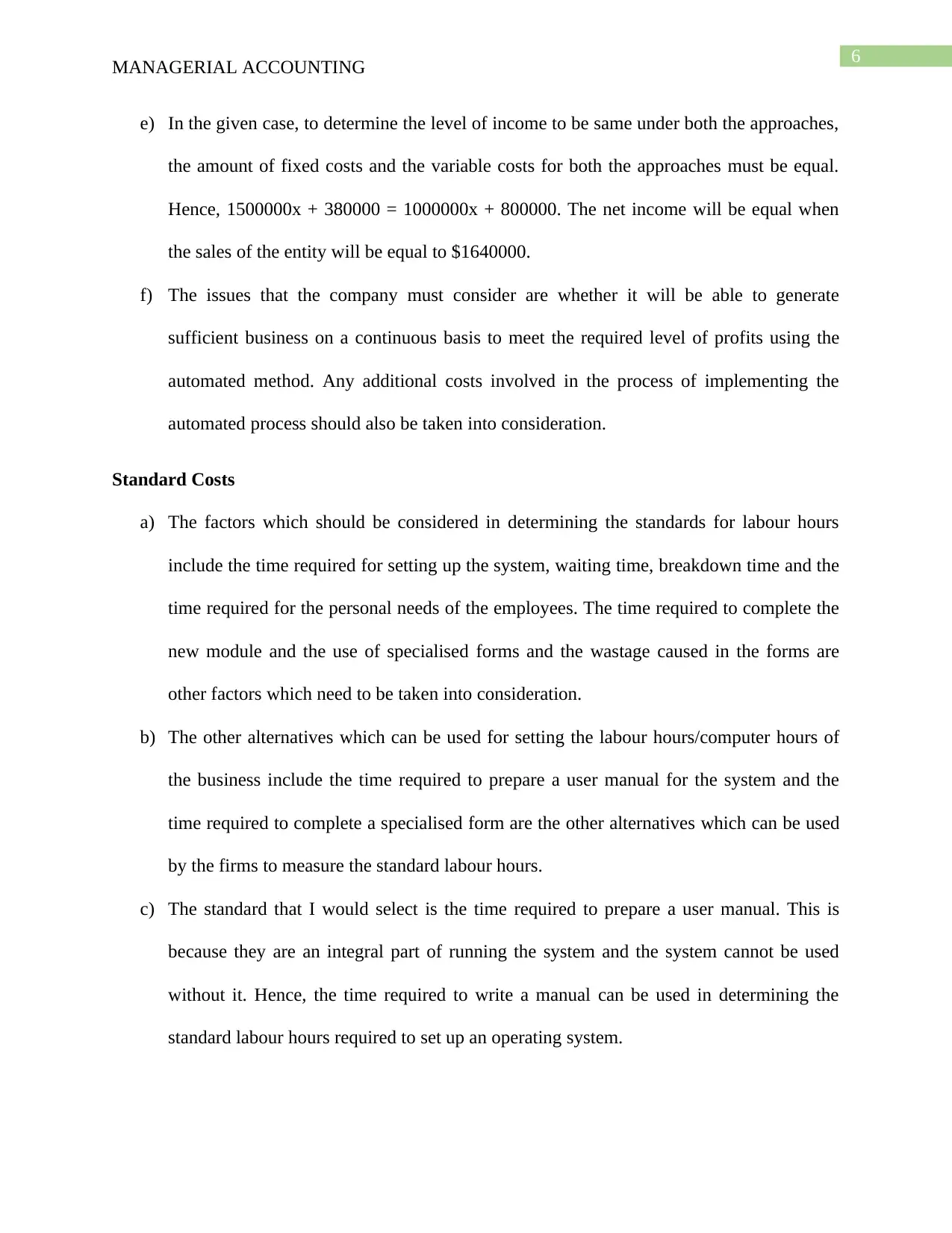
6
MANAGERIAL ACCOUNTING
e) In the given case, to determine the level of income to be same under both the approaches,
the amount of fixed costs and the variable costs for both the approaches must be equal.
Hence, 1500000x + 380000 = 1000000x + 800000. The net income will be equal when
the sales of the entity will be equal to $1640000.
f) The issues that the company must consider are whether it will be able to generate
sufficient business on a continuous basis to meet the required level of profits using the
automated method. Any additional costs involved in the process of implementing the
automated process should also be taken into consideration.
Standard Costs
a) The factors which should be considered in determining the standards for labour hours
include the time required for setting up the system, waiting time, breakdown time and the
time required for the personal needs of the employees. The time required to complete the
new module and the use of specialised forms and the wastage caused in the forms are
other factors which need to be taken into consideration.
b) The other alternatives which can be used for setting the labour hours/computer hours of
the business include the time required to prepare a user manual for the system and the
time required to complete a specialised form are the other alternatives which can be used
by the firms to measure the standard labour hours.
c) The standard that I would select is the time required to prepare a user manual. This is
because they are an integral part of running the system and the system cannot be used
without it. Hence, the time required to write a manual can be used in determining the
standard labour hours required to set up an operating system.
MANAGERIAL ACCOUNTING
e) In the given case, to determine the level of income to be same under both the approaches,
the amount of fixed costs and the variable costs for both the approaches must be equal.
Hence, 1500000x + 380000 = 1000000x + 800000. The net income will be equal when
the sales of the entity will be equal to $1640000.
f) The issues that the company must consider are whether it will be able to generate
sufficient business on a continuous basis to meet the required level of profits using the
automated method. Any additional costs involved in the process of implementing the
automated process should also be taken into consideration.
Standard Costs
a) The factors which should be considered in determining the standards for labour hours
include the time required for setting up the system, waiting time, breakdown time and the
time required for the personal needs of the employees. The time required to complete the
new module and the use of specialised forms and the wastage caused in the forms are
other factors which need to be taken into consideration.
b) The other alternatives which can be used for setting the labour hours/computer hours of
the business include the time required to prepare a user manual for the system and the
time required to complete a specialised form are the other alternatives which can be used
by the firms to measure the standard labour hours.
c) The standard that I would select is the time required to prepare a user manual. This is
because they are an integral part of running the system and the system cannot be used
without it. Hence, the time required to write a manual can be used in determining the
standard labour hours required to set up an operating system.
Paraphrase This Document
Need a fresh take? Get an instant paraphrase of this document with our AI Paraphraser
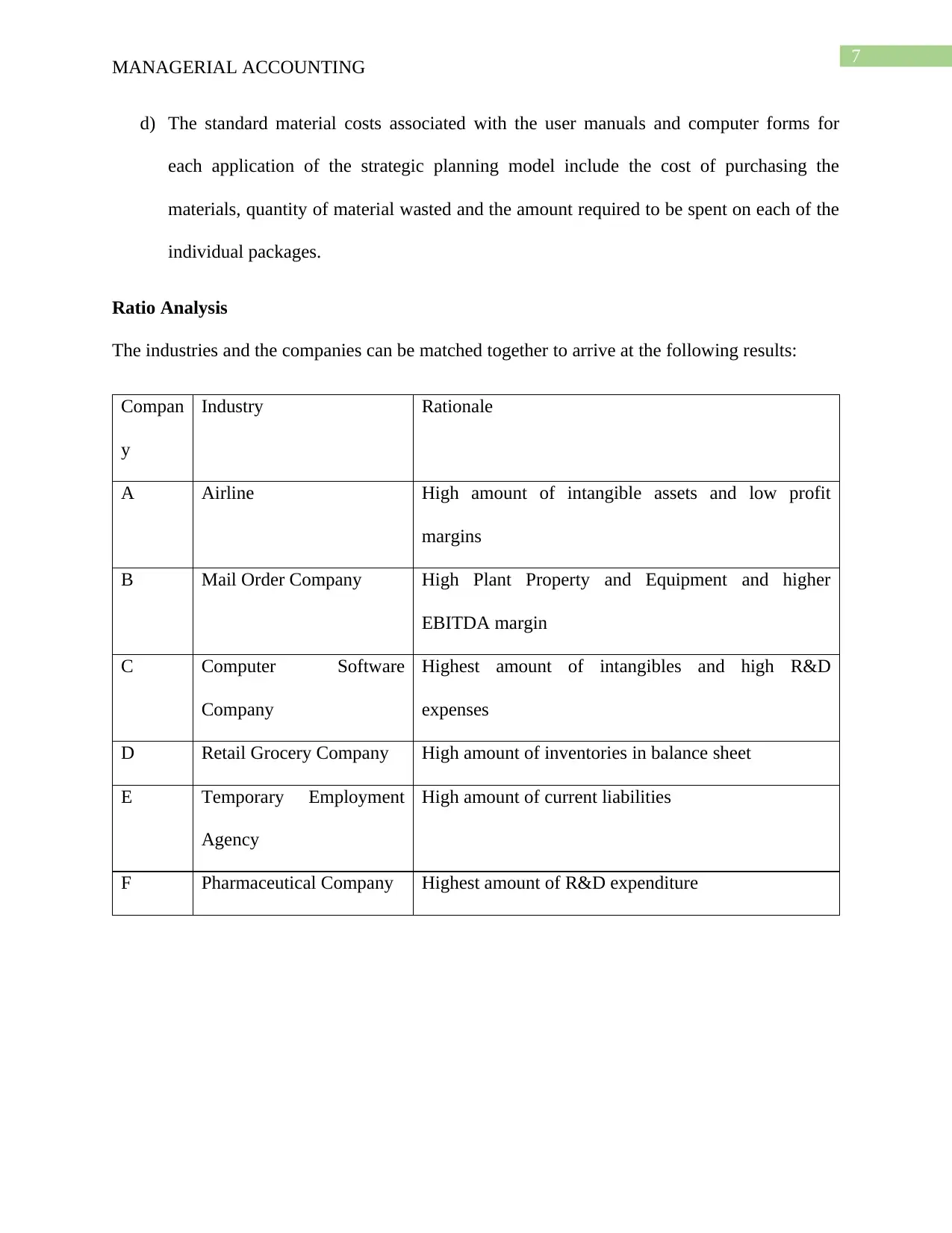
7
MANAGERIAL ACCOUNTING
d) The standard material costs associated with the user manuals and computer forms for
each application of the strategic planning model include the cost of purchasing the
materials, quantity of material wasted and the amount required to be spent on each of the
individual packages.
Ratio Analysis
The industries and the companies can be matched together to arrive at the following results:
Compan
y
Industry Rationale
A Airline High amount of intangible assets and low profit
margins
B Mail Order Company High Plant Property and Equipment and higher
EBITDA margin
C Computer Software
Company
Highest amount of intangibles and high R&D
expenses
D Retail Grocery Company High amount of inventories in balance sheet
E Temporary Employment
Agency
High amount of current liabilities
F Pharmaceutical Company Highest amount of R&D expenditure
MANAGERIAL ACCOUNTING
d) The standard material costs associated with the user manuals and computer forms for
each application of the strategic planning model include the cost of purchasing the
materials, quantity of material wasted and the amount required to be spent on each of the
individual packages.
Ratio Analysis
The industries and the companies can be matched together to arrive at the following results:
Compan
y
Industry Rationale
A Airline High amount of intangible assets and low profit
margins
B Mail Order Company High Plant Property and Equipment and higher
EBITDA margin
C Computer Software
Company
Highest amount of intangibles and high R&D
expenses
D Retail Grocery Company High amount of inventories in balance sheet
E Temporary Employment
Agency
High amount of current liabilities
F Pharmaceutical Company Highest amount of R&D expenditure
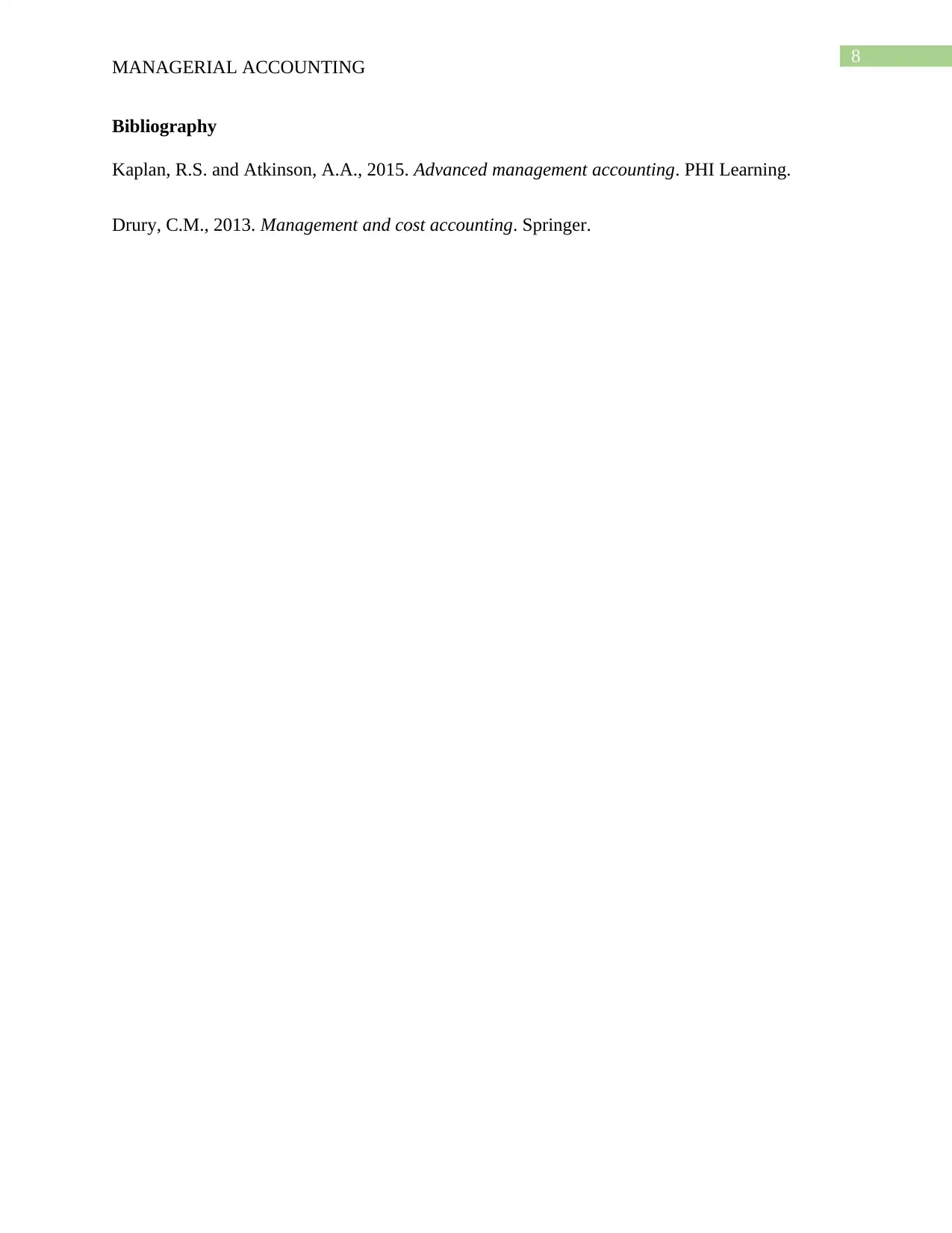
8
MANAGERIAL ACCOUNTING
Bibliography
Kaplan, R.S. and Atkinson, A.A., 2015. Advanced management accounting. PHI Learning.
Drury, C.M., 2013. Management and cost accounting. Springer.
MANAGERIAL ACCOUNTING
Bibliography
Kaplan, R.S. and Atkinson, A.A., 2015. Advanced management accounting. PHI Learning.
Drury, C.M., 2013. Management and cost accounting. Springer.
⊘ This is a preview!⊘
Do you want full access?
Subscribe today to unlock all pages.

Trusted by 1+ million students worldwide
1 out of 9
Related Documents
Your All-in-One AI-Powered Toolkit for Academic Success.
+13062052269
info@desklib.com
Available 24*7 on WhatsApp / Email
![[object Object]](/_next/static/media/star-bottom.7253800d.svg)
Unlock your academic potential
Copyright © 2020–2025 A2Z Services. All Rights Reserved. Developed and managed by ZUCOL.



